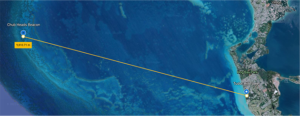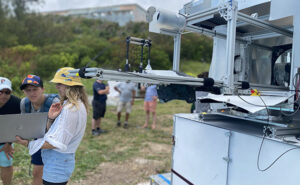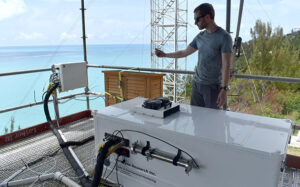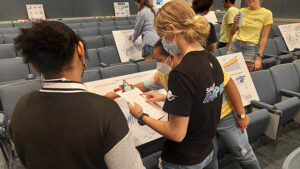International Research Program Examines Climate-Changing Trace Gases in the Skies over Bermuda

In May, the first of a two-part international research investigation brought researchers from the U.K. and U.S. to Bermuda. The project, called the Bermuda boundary Layer Experiment on the Atmospheric Chemistry of Halogens (BLEACH), hopes to use Bermuda’s unique mid-Atlantic location to shed light on the impacts of a group of elements, called halogens, on the marine atmosphere. (BLEACH researchers from left: Lewis Marsden, doctoral student, University of York; Aly Fritzmann, doctoral student, University of California at Los Angeles; Phil Rund, graduate research assistant, University of Washington; Will Drysdale, postdoctoral research associate, University of York; Gordon Novak, research scientist, NOAA; John Halfacre, postdoctoral research associate, University of York; Andrew Peters, BIOS associate scientist and lead scientist of the Tudor Hill Marine Atmospheric Observatory).
In late May 2022, a team of scientists from the University of California at Los Angeles (UCLA, U.S.), the University of Washington (UW, U.S.), the University of York (York, U.K.), and the National Oceanic and Atmospheric Administration (NOAA, U.S.), traveled to Bermuda to begin the installation of a new 30-foot (10 meter) sampling tower with an accompanying suite of state-of-the-art research instruments at the Tudor Hill Marine Atmospheric Observatory (THMAO). The location of this BIOS-operated facility in the middle of Bermuda, itself in the middle of the North Atlantic Ocean, provides a valuable research opportunity for scientists that study the long-range transport of materials across entire ocean basins.
The project, called the Bermuda boundary Layer Experiment on the Atmospheric Chemistry of Halogens (BLEACH), aims to study the impacts of bromine, chlorine, and iodine—elemental gases known as halogens—on the marine atmosphere. The team will visit the site for two 5-week periods, once during summer 2022 and again during winter 2023. These visits will allow researchers to deploy scientific instruments on the new sampling tower and at an offshore navigation beacon, located approximately 32,000 feet (9,819 meters) off Bermuda’s southern coast.

The BLEACH project leverages the BIOS-operated Tudor Hill Marine Atmospheric Observatory, which has operated since 1988 to collect year-round data on the chemical and physical properties of the atmosphere. Currently supported by the U.S. National Science Foundation (NSF), the facility supports routine sampling activities that contribute to long-term time-series records, as well as visiting research investigations, such as the recent NASA ACTIVATE mission.
“Despite the importance of halogens in atmospheric chemistry, much remains unknown about what processes control their levels in the marine atmosphere, primarily due to a lack of observations over the open ocean,” said Becky Alexander, professor of atmospheric sciences at UW and overall project lead for BLEACH. She is joined on the project by another UW team member, co-principal investigator (co-PI) Joel Thornton, professor of atmospheric sciences.
Halogens and Earth’s Ozone Layer
In the early 1980s, scientists discovered that drastic depletions in the ozone layer in the stratosphere (6 to 31 miles, or 10 to 50 kilometers above Earth’s surface) above Antarctica coincided with high levels of the halogen chlorine. Ozone in the stratosphere absorbs harmful ultraviolet (UV) radiation, protecting life on Earth. The near-destruction of the stratospheric ozone layer during the spring over Antarctica prompted the development and ratification of the Montreal Protocol.
Representing the first universally ratified United Nations treaty, the Montreal Protocol eventually phased out ozone-depleting chlorofluorocarbons (CFCs)—a man-made source of halogens—worldwide by 2008. Unlike the halogens that occur naturally in the troposphere, synthetic CFCs accumulate in the stratosphere—the same place where Earth’s protective ozone layer is the thickest.
However, in the troposphere (the lower atmosphere, which extends from Earth’s surface upwards to 10 miles, or 16 kilometers) ozone is a harmful air pollutant. Here, natural halogens, originating mainly from sea salt aerosol and the surface ocean, act to deplete surface ozone and cleanse the atmosphere. The chemical reactions that generate reactive halogens in the troposphere are not well understood, prompting the deployment of the BLEACH field campaign to better understand their sources and sinks.
Bermuda-Based Research
With funding from the U.K. Natural Environment Research Council (NERC) and the U.S. National Science Foundation’s (NSF) Atmospheric Chemistry Program, funded jointly through the NSFGEO-NERC program, the BLEACH team is measuring halogen species (bromine, chlorine, iodine), ozone, and other environmental parameters in the troposphere, such as wind speed and direction. During each of the five-week research periods, the team will also conduct sampling of the inshore seawater to better assess the cycling and fluxes of some of these chemicals between the ocean and atmosphere.

One of the four scientific instruments used in the field during the BLEACH campaign is this Long Path Differential Optical Absorption Spectrometer (LP-DOAS), run by Jochen Stutz, professor of atmospheric sciences and ocean sciences at the University of California at Los Angeles. The LP-DOAS set-up consists of a telescope (shown here) that sends a powerful beam of white light to a reflective mirror (located at the Chub’s Head navigation Beacon). The reflected beam is received by the telescope, focused into a fiberoptic bundle, and fed into a spectrometer. For the BLEACH project, the LP-DOAS is measuring levels of ozone and iodine oxide, a halogen species that destroys ozone in the troposphere.
A variety of specialized instruments and measurement techniques are being employed by the BLEACH team to quantify both reactive gases and particulate halogens (also known as aerosols). Reactive gaseous halogens include hydrogen chloride (HCl), bromine monoxide (BrO), nitryl chloride (ClNO2), and iodine monoxide (IO), among others. These gases are formed in the atmosphere following reactions on sea-salt aerosol or at the air-sea interface, which are enriched in halogens. Particulate halogens include the negatively charged ions of halogen species, including bromide (Br-), chloride (Cl-), and iodide (I-).
Combined, a total of eight scientific instruments from four institutions will be utilized during the project, each designed to measure different halogen species and abundances.

One of the instruments installed in the new sampling tower at the Tudor Hill Marine Atmospheric Observatory is designed to detect hydrogen chloride, which can impact ozone levels and pollutant lifetimes in the troposphere. Here, John Halfacre, postdoctoral research associate at the University of York, explains how the instrument collects samples of marine air.
NOAA research chemist and BLEACH PI Andrew Rollins is also operating an instrument designed to detect nitrogen oxides in the troposphere. Nitrogen oxides originate from both natural (e.g., decomposition of organic matter, lightning strikes, and sea-atmosphere interfaces) and man-made sources (e.g., automobile exhaust and power plant emissions). However, they are also responsible for air pollution, much of which is hazardous to human health. Nitric oxide (NO), one of the nitrogen oxides, also reacts with water vapor to form acid rain.
“The laser-induced fluorescence instrument was designed for use on larger platforms, such as the NOAA DC-8 airplanes,” Rollins said. “But this new technique has been proven to be the best-available for measuring nitric oxide in very low nitric oxide environments that are characteristic of much of the troposphere.”
The team from the University of York includes PI Mat Evans, professor of atmospheric chemistry modeling; co-PI Lucy Carpenter MBE, professor of physical and atmospheric chemistry; co-PI Pete Edwards, independent research fellow; and James Lee, National Centre for Atmospheric Science research fellow.
“It’s been fantastic to be able to work with our American colleagues and BIOS on this project,” Evans said. “The joint NSF and NERC funding has really made this possible. We’ve all been able to do so much more than we could have done alone.”
“The observational data will be interpreted using numerical models to provide a quantitative understanding of the sources and sinks of halogens in the marine atmosphere,” said Becky Alexander, BLEACH PI and professor of atmospheric sciences at UW. “The combined observational and modeling approach will result in a more accurate assessment of the impact of halogen chemistry on the atmosphere and an improved capacity to predict the impact of climate change on the composition of marine air.”
In addition to the scientific merit of this investigation, whose data will be used to inform 3-D models of atmospheric chemistry driven by meteorological input from NASA, the BLEACH campaign provided unique educational opportunities for BIOS education programs.
Education and Engaging Expertise
In June 2022, Kaitlin Noyes, BIOS director of education and community engagement, hosted an NSF-sponsored workshop designed for educators interested in using real-world ocean science data as a teaching resource in their classrooms. Over the course of a week, participants engaged with researchers and data managers, learned how to navigate the DataBytes website and teaching resources, and visited field locations—including the THMAO where they met members of the BLEACH team. Eventually, data from the BLEACH campaign will be used to develop a module on the DataBytes website about the seasonality of ozone at the Observatory.

As part of the public education component of the project, Kaitlin Noyes, director of education and community engagement at BIOS, partnered with the Bermuda Underwater Exploration Institute for a Climate Data Workshop. Bermuda’s youth climate leaders used data from the Tudor Hill Marine Atmospheric Observatory to learn about climate and atmospheric science.
The following month, in July, BIOS’s Ocean Academy hosted a Climate Data Workshop in partnership with the Bermuda Underwater Exploration Institute’s (BUEI’s) year-long Youth Climate Summit program. This workshop was part of BIOS’s ongoing efforts to broaden public understanding and awareness of the types and applications of measurements collected at the THMAO.
“During the workshop, students learned about the types of data collected at Tudor Hill and focused on understanding how the concentration of greenhouse gases have changed at the Observatory since the 1980s,” said Noyes, who is also a PI on the BLEACH campaign. The Climate Data Workshop also gave participants the opportunity to learn about climate and atmospheric science from Andrew Peters, BIOS associate scientist and principal investigator of the THMAO, and hear from BIOS interns Caroline Alexander and Kendall O’Farrell.
“It was so important for our Youth Climate Summit students to revisit the topic of climate science, and additionally learn more about atmospheric science and the tools and techniques used by scientists at BIOS,” said Rosemarie McMahon, consulting director to the Youth Climate Initiative at BUEI. “Learning how Bermuda is playing a leading role internationally in climate research and improving our scientific understanding of climate change made a great impact on all the students.”
The international scientific investigation is a landmark moment for both Peters and the THMAO, representing the future of ocean and atmospheric science research where complex global questions require facilities that can leverage state-of-the-art technologies and promote cross-disciplinary collaborations.
“The BLEACH project is one of the largest research collaborations that has worked at the Tudor Hill facility, and it has further demonstrated the value of the facility for conducting marine atmospheric research in the mid-ocean environment,” Peters said. “It also shows the value of scientific collaborations such as this, bringing teams of experts together with their instrumentation to make use of this unique opportunity. The BLEACH team has been a pleasure to work with and I look forward to building on this experience and welcoming more groups to Bermuda in the future.”
